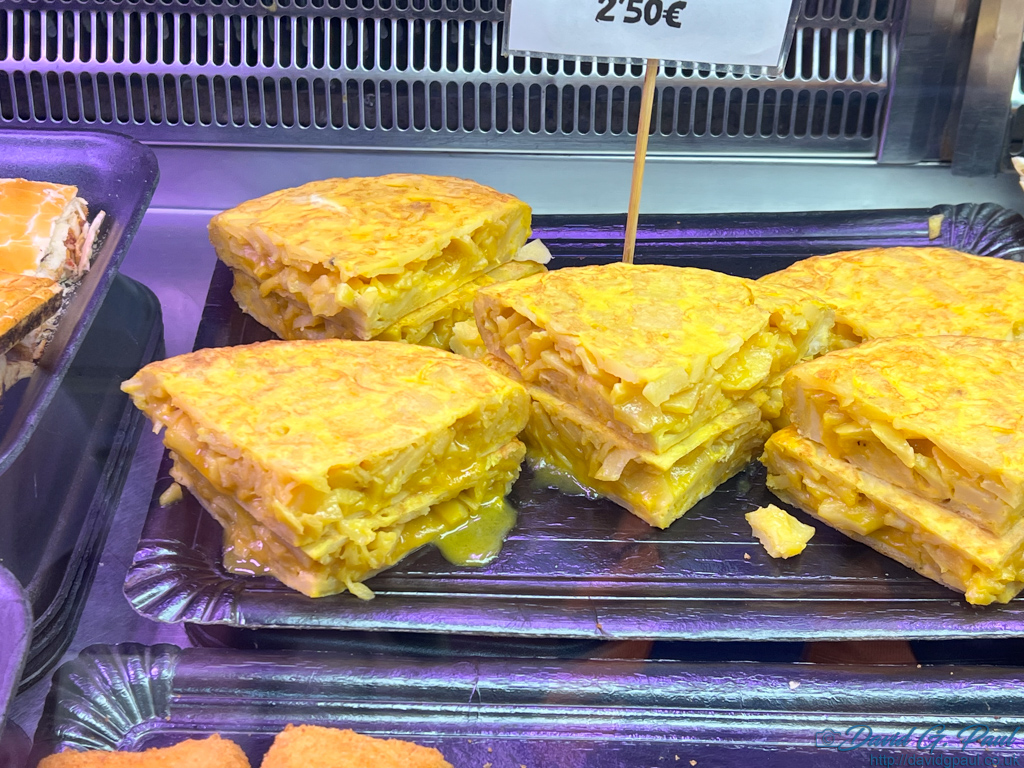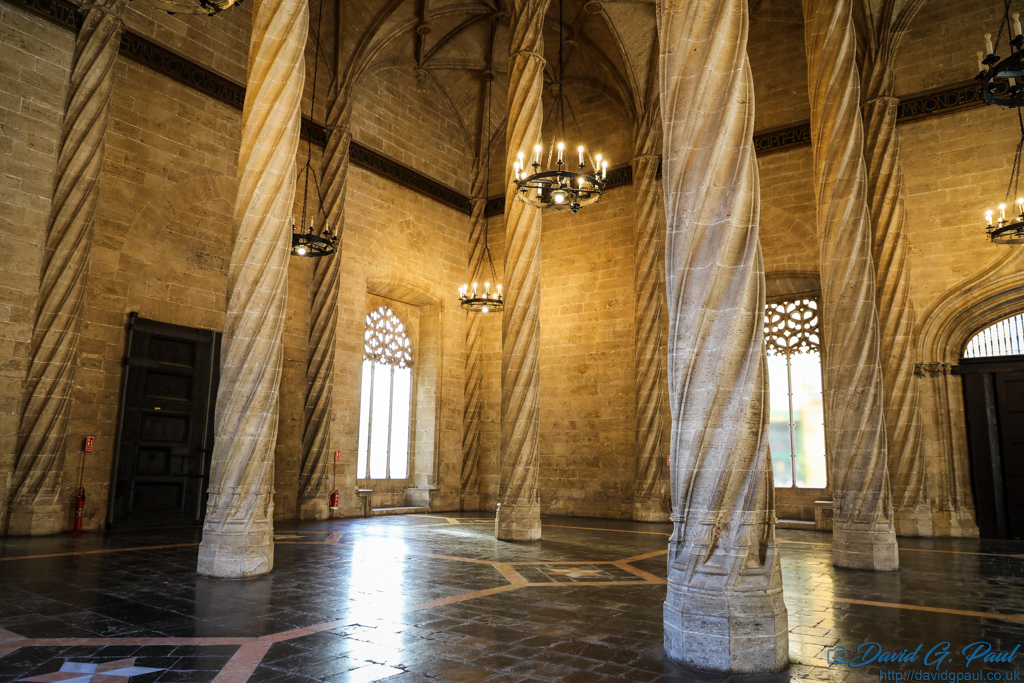I tried persimmon for the first time, with a bowl of granola. It wasn’t bad, but maybe not the most exciting fruit either. We took our time getting ready, and headed out once more into the warm Valencian sun sometime after 10:00 for our second day of sightseeing.
The 72 hour SUMA card we’d bought only covered our first few days in the city, so we started off by walking to Xàtiva metro station to get a new 24 hour ticket that would last long enough to cover our journey to the tour pick-up point tomorrow as well. When we tried to recharge our existing card it wouldn’t let us, but I noticed that the we were a few minutes earlier using the machine than the time we’d bought our initial tickets, so felt it wasn’t letting us change the ticket type before it had expired.
When we reached Alameda, Carmen had another go with the machines there and found that if you press the ‘Change Title’ button, it gives you the option of changing what type of card you can top up with. As we left the station we passed the Convento de Santo Domingo, and went looking for the Cervelló Palace.
The palace isn’t that obvious from the road as it fits in with the surrounding buildings very well. It was €2 to look around the several rooms upstairs, and for what was there it was definitely worth the visit. It seems its relative obscurity is why it was almost completely empty when we visited except for one person who seemed to be timing his quick walk doing a lap of the rooms. It was almost like someone in a heist movie trying to get their timings down.

There really is so much you can find by accident in Valencia, as from there we walked past one place with golden hands as door knockers, and both were holding a small orange - one of the biggest fruit exports from Valencia. It should come as no surprise we passed by yet another church too - I don't think you can throw a stone without hitting a church there. This one was the Church of Sant Tomàs and Sant Felip Neri, and just around the corner from there is the Admiral's Palace. Eventually though, we made it to the Torres de Serranos and paid €2 each to go up. I noticed that the receipts for this and Cervelló Palace were near identical, as would the Silk Market one be later. They both say 'Ajuntament de Valencia' (Valencia City Council), with different codes for 'Entrada General' - if the money for these all go to the council, it makes some sort of sense why the prices are consistent.

There are 132 steps to climb to reach the top, and I think how easy it is to climb does depend on how you are with heights as some parts are quite open with low railings, and steep steps. Carmen did seem to find some bits more difficult than others, but she made it to the top and back down okay. She did good! The view from the top is worth it though as you can see across El Carmen to the other tower, and across the Turia Gardens to Tavernes Blanques and beyond.
As we’d not seen any cats at the House of Cats yesterday, we headed there next to try again. Once again, there were no cats present. We headed back from there to the Central Market, and wandered around there looking for things we wanted to eat to create our own tapas - a meal made from small savoury snacks.
To start with, Carmen bought us both a tortilla de patatas for €2.50 each, and then she had some olives from elsewhere. The stall she got them from had so many different types of olive from all over; I had no idea there were so many. I saw empanadas, and realising they were a Spanish and not South American dish, it was clear we needed to try one of those as well. I had a chorizo and chimichurri one that was quite messy, and scalding hot. Carmen decided she'd try the 'roast and provolone' one. At €2.95 and €3.50, we'd still spent very little on lunch compared to a more traditional tapas, but we weren't done yet - there was so much more we could try. Carmen then bought us some iberico ham, and a selection of cheeses to try, whilst I got us a pack of three fartons for €2.00.

The market can take quite some time to look around if you want to see everything, even longer if you want to try as many different foods as you can. The one area we didn't spend long in is the wet market, that was mostly fish. Elsewhere in the market there are so many places that have large legs of ham suspended from above. For those needing bathroom facilities, they have these downstairs in Central market, costing €1.00 per person, payable using card only.
We sat outside to eat the last of the food. The cheeses varied in flavour, with one tasting like tomato, one like pesto, another tasting a little of herbs, and the final one was like cheddar but is very likely to have been either manchego or zamorano. The fartons were like a light doughnut texture.
The market we’d seen outside wasn’t on today, so the area felt a little more open. The Silk Market, La Lonja de la Seda, also wasn’t as busy, so we went inside there for €2.00 each. It was pretty safe to assume most places you'd want to visit was going to cost around the same amount. The Silk Market has a large hall with many ornate columns around the edges, and then a few smaller rooms around the courtyard.

With yet another place ticked off our list, we went back to Valencia Cathedral in the hope that the queue wouldn't be too bad today. After everywhere else being so cheap, paying €10.00 felt a little steep, although is cheaper than some cathedrals I've visited. It seemed a little more worthwhile after finding there was a museum attached to the church with several things to look at, and an archaeological dig underneath the church as well.
Before finding the entrance to the museum I'd gone round the back of the Altar Major and had seen the mummified hand of Saint Vincent of Saragossa, who was martyred in Valencia in 303 CE. What I couldn't see, and thought would be more obvious, was the chalice that they refer to as the Holy Grail.
I'd read this cathedral had a chalice that has the strongest claim to being the fabled Holy Grail, due to the determined age of the original agate cup part of the chalice. Whilst many of the stories will be embellished, it's not impossible that the person behind these stories could have had at least some basis in reality for this cup to then exist.
The legend goes that the cup was taken from Jerusalem to Rome by Saint Peter, and kept there until 258 CE when Pope Sixtus II instructed Saint Lawrence of Huesca to remove it to keep it safe from persecution. He sent this to his home in the Pyrenees, hidden away from the Moor invaders, until it was entrusted to the monks of the monastery of San Juan de la Peña. The earliest written record of this story comes from Valencian and Aragonese sources in the 15th-16th centuries to explain how the fabled Holy Grail ended up there, there are no contemporary sources, and the Passio Sancti Laurentii does not mention it - the biggest red flag for the claims authenticity.

The monastery's own records indicate they held a cup they referred to as the Holy Grail as far back as 14th December 1134 in a Vida written by Don Carreras Ramírez, canon of Zaragoza. The original document no longer exists, so could be an addition from a later compiler, but copies of it read as:
…Calix in quo Christus consecravit sanguinem suum in cena Domini
(The chalice in which Christ consecrated His blood at the Lord’s Supper)
The record contains no other detail, such as where it came from.
After that, it is then known that the monks gifted the cup to King Martin I of Aragon in 1399. The fact that he requested the grail whether it was real or not, or where it came from before the monastery held it, is in little doubt. There are 14th century royal chancery letters, and Pergamino nº 136: a parchment recording receipt of the delivery on 26th September 1399. These two sets of documents can't guarantee authenticity, but they do confirm the item was venerated.
…el prior del monasterio entregó al monarca … el cáliz de piedra en el que nuestro Señor Jesucristo consagró su preciosísima sangre y que san Lorenzo envió con una cart
(…the prior of the monastery presented to the monarch… the stone chalice in which our Lord Jesus Christ consecrated his most precious blood and which Saint Lawrence sent with a letter)
The Holy Grail was then given to the cathedral in 1437 by King Alfonso V of Aragon as collateral for a loan, and at the time was situated inside the old Chapter House building. In 1916, this became the Chapel of the Holy Chalice, and is now part of the cathedral structure itself.
I'd also seen signs that suggested it may have been elsewhere in an exhibition, so didn't look too hard for it. I photographed a small room that was quite plain, except for a decorative altar, and left the cathedral to continue our wandering. I hadn't realised I'd actually photographed the chalice in that room, otherwise I would have taken a much closer photograph.
As if we’d not already had enough to eat, we then stopped at Llinares once again to try another two of their fifty flavours of ice cream. This time I had lemon cheese and manjar blanco which was white chocolate with caramel.
We attempted to find a shop Carmen wanted to return to, but found they were closed again, and wouldn’t be open again until tomorrow. So, we then headed to the tram stop on the other side of the Turia Gardens from the Torres de Serranos and took that to Malvarrosa beach.
I’d booked Carmen a salsa and bachata lesson by the beach, which had been rescheduled from 16:00 to 18:00 due to the teacher having a family emergency. We arrived around 17:20, and waited around as the sun set, and it got cooler. As the time got closer we wandered around but without a specific location having been provided, we were unsure where to be. I’d messaged the organiser as well, but hadn't yet got a reply. We began looking at photographs from the website, thinking that would help, but we could see two different buildings, and they were about 200-400 metres apart.

When it got to 18:20 we gave up and messaged the organiser again to tell them this, as we walked towards 'Pans and Company' to at least get a drink. I was keen to have something to eat too, so suggested we get a sharing plate of patatas bravas, and twenty 20 pops de pollo which with the tea came to €16.00.
Whilst there, the organiser messaged to say she'd meant to send a message earlier to say the teacher couldn't make it, and would now send us a full refund and something towards the cost of travel. In reality, we hadn't actually received a full refund as the lesson cost me £22.27, and she'd only refunded £20.88. I wasn’t going to argue over £1.39 though.
At 19:00 we headed to the bus stop and managed to catch the 93 bus just in time, and this got us back for 19:40. We’d been out for just over nine hours!